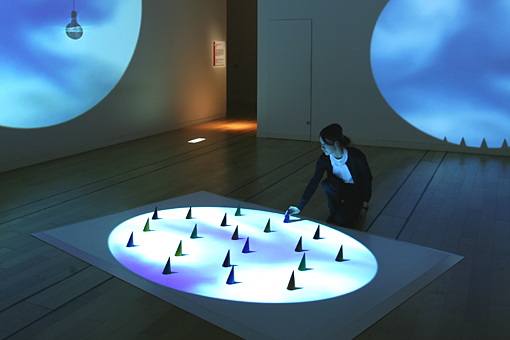"KAGE"
1997/2007
minim++
 photo: KIOKU Keizo
photo: KIOKU Keizo
On the floor, lit by the round-shaped light are spine-like objects. It appears that the light from the ceiling casts shadows of these cone-shaped objects onto the floor. However, when you touch a cone, its shadow starts to move; for example, it rotates around the object like a sundial or expands and contracts. If you touch other cones, you will see a diversity of reactions, such as all shadows starting to move or suddenly becoming colored, as the shadows of individual cones react differently and in combination.
In this work, although they appear to be real, these shadows are created by CG. All objects, except for those that are completely transparent, have shadows. In other words, a shadow proves the existence of an object. However, while serving as a certification of existence, the shadow itself is immaterial, just like images displayed on a monitor or screen. The shadow is the origin of visual media devices such as the shadowgraph and magic lantern. In this work, the shadows create their own world of imagination in response to the active involvement of the viewers. And we are forced to recognize our own shadow and existence as we see the real shadow of ourselves and the fictitious computer-generated shadows on the same floor. minim++ is a media products team led by CHIKAMORI Motoshi and KUNOH Kyoko. They produce works with the concept of "delivering daily trivial things or objects to the world by adding a few ingenuities." This team does not consist of fixed members, but is participated in by artists, programmers, and designers, who collaborate on a project basis.
minim++ is a media products team led by CHIKAMORI Motoshi and KUNOH Kyoko. They produce works with the concept of "delivering daily trivial things or objects to the world by adding a few ingenuities." This team does not consist of fixed members, but is participated in by artists, programmers, and designers, who collaborate on a project basis.
In this work, although they appear to be real, these shadows are created by CG. All objects, except for those that are completely transparent, have shadows. In other words, a shadow proves the existence of an object. However, while serving as a certification of existence, the shadow itself is immaterial, just like images displayed on a monitor or screen. The shadow is the origin of visual media devices such as the shadowgraph and magic lantern. In this work, the shadows create their own world of imagination in response to the active involvement of the viewers. And we are forced to recognize our own shadow and existence as we see the real shadow of ourselves and the fictitious computer-generated shadows on the same floor.

Interactive
Since 1990, the development of high-speed computers and sensors that detect human gestures and changes in the environment has attracted a great deal of interest in artworks that can look or respond differently as the viewers get involved in it. Prominent characteristics of "Interactive Art" are that the work can function only when viewers proactively participate in it, and that the work never stays in a single status as it changes over time, presenting itself differently depending on the viewer.
